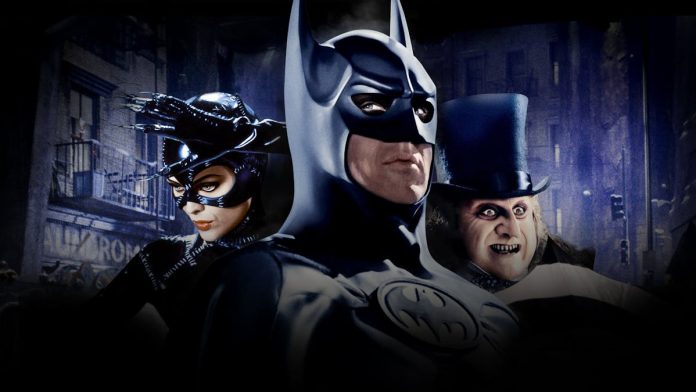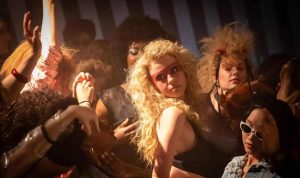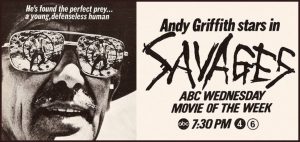
Hollywood History returns to Last Movie Outpost. Last time around we looked at the insanity of 1989 and The Summer Of The Bat, as Batmania swept the globe. This time, we salvage more from our old site as we go beyond Batman and into the world of Batman Returns. A slam-dunk, home run of a sequel… right? Wrong! Scratch the surface, look at the history of it, and you find a fascinating story, and a case study of things that can go wrong when making a sequel to a phenomenon.
Batman Returns
That phenomenon was Tim Burton’s Batman (1989) and it had a long and tortuous journey to the big screen. It was a massive chasm between producers and the studio who had completely different views of what it should be. When it did finally make it onto the screen, it was after intense wrangling all around, false starts, casting U-turns, and incredibly heavy studio interference.
The finished article is regarded as something of a Tim Burton triumph. A dark, gothic fairytale of a superhero movie. The harsh truth is that it represents Tim Burton with the studio keeping the director of Beetlejuice firmly in line.
When it started to become clear what they had on their hands with Batman, Warner Bros. did not hesitate. The fifth-highest-grossing movie of all time when released was going to get a sequel. They intended filming to start as soon as May 1990.
The studio had purchased the $2 million worth of Gotham City sets at Pinewood Studios in England for at least two sequels. They were kept under 24-hour guard because it was cheaper to maintain the existing sets than build new ones from scratch.
After Jack Nicholson’s show-stealing turn as the Joker in Batman, all eyes turned to the villain roster. Initially, Robin Williams and Danny DeVito were wanted by the studio to play Riddler and Penguin… despite there being no script in place.
As the script developed, so did the villains who were to appear. The writer of the original Batman, Sam Hamm, had an initial story idea that was centered around Billy Dee Williams as District Attorney Harvey Dent. It would show his turn to evil as supervillain Two-Face.
Warner Bros. simply interfered again and wanted the main villain to be the Penguin as they saw the character as Batman’s most prominent enemy after the Joker.
Catwoman came into the story because Hamm was interested in her character. As well as featuring Dent, Hamm’s drafts continue straight from Batman in other ways. The relationship between Bruce Wayne and Vicki Vale was to be extended with their engagement being a plot point.
The Penguin was less of a freak more of a criminal who used trained birds as weapons. Catwoman was more overtly sexual and murdered groups of men in a feminist revenge.
A rewrite saw the genesis of a central idea where Penguin and Catwoman team up to frame Batman, as in the final movie. In this early draft, it was for the murders of Gotham’s wealthiest citizens.
In the process of targeting the wealthy of Gotham, they find the secrets buried deep beneath Wayne Manor.
The Christmas theming also originates from Hamm’s rewrite. Batman’s sidekick, Robin, was to make his first appearance. Assault rifle-wielding Santas were clearly the inspiration for the Clown-infested circus gang.
The studio was forever pushing for certain casting. Hamm had suggested Marlon Brando as the Penguin, but Warner Bros. preferred Dustin Hoffman. Christopher Lloyd or Robert De Niro.
This was all very academic at this point, as one thing they did not have was a director.
Burton And Robin
Tim Burton had very little interest in doing a sequel. Despite pressure from Warner Bros. to commit, a chance to finalize a script, and the request to mobilize quickly, he remained unconvinced. He had described making a sequel as a:
“…dumbfounded idea…”
He even went as far as publicly saying:
“Sequels are only worthwhile if they give you the opportunity to do something new and interesting. It has to go beyond that, really, because you do the first for the thrill of the unknown. A sequel wipes all that out, so you must explore the next level.”
He was already into production on Edward Scissorhands and had started writing The Nightmare Before Christmas. Before he would commit, he had a few conditions. Given the sheer scale of the success of Batman, the studio could not really refuse any of them.
Firstly, he wanted a rewrite. To work with him on this, he brought in Daniel Waters. The Santas were replaced, and the Penguin became the grotesque and Burtonesque version we see in the finished movie. Burton went full circle and went back to the original studio idea of Danny DeVito for the role.
Next, Burton set his sights on an enemy. Producer Jon Peters has a reputation that deserves a Hollywood History article all of its own. Suffice it to say, Burton disliked him intensely and saw him as a source of pain on Batman. For the sequel, Burton insisted he was downgraded to Executive producer and completely banned from the set.
Next, he insisted he would not shoot in England, as he felt Batman had “suffered from a British subtext” which he felt out of place. So those expensively bought and preserved sets back at Pinewood were trashed in favor for new creations in Burbank, California.
As part of his collaboration on the rewrite, he once again exorcised the character of Robin, as he had in the original, despite Marlon Wayans already being cast in the role. Wayans still receives residuals to this day due to the contracts he signed.
Finally, Burton’s absolute deal breaker – less studio interference. He wanted almost total creative control. Warner Bros., busy swimming laps in a pool of money that Batman filled for them, accepted all these terms.
It was from this point on that things started to go wrong.
Burton Begins
Burton was confirmed to direct the sequel in January 1991, with filming scheduled to begin later that year for a 1992 release date.
With the shift from the UK to the US, Burton also took the opportunity to replace the highly experienced and skilled British crew from the original with some of his former collaborators, hence creating a “Burton Club” on set. These included cinematographer Stefan Czapsky, production designer Bo Welch, makeup artist Ve Neill, and art directors Tom Duffield and Rick Henrichs.
As the rewrite progressed, Hamm found himself less involved as Waters’ ideas began to replace his own. Burton had liked Waters’ script for the dark comedy Heathers (1988) and with his newfound creative control he was only veering in one direction of tone and creativity – Burton’s standard setting of darker. Burton felt Waters was more in tune with him than Hamm.
Waters said that he did not like Batman, and had no interest in following its narrative threads. So Vicky Vale was jettisoned. He also said he had no interest in acknowledging the comic-book histories of the characters he was using in Batman Returns, so new origins could be created for Penguin and Catwoman.
The character of Catwoman was significantly changed to less overtly feminist and sexual, into a working-class anti-hero. Burton also introduced the supernatural aspect around the character and her resurrection with nine lives. This tonal shift was also starting to flow elsewhere in the movie.
Waters also said he had no interest in preventing Batman from killing people and that the character should reflect contemporary, darker times. He felt the idea of a hero leaving captured villains for the authorities was outdated.
This opened the door to, and probably enabled, Burton’s slide to an even darker tone. This would return to haunt the production as release neared.
Luckily Michael Keaton had some influence from the first movie and insisted that much of the bitter and cynical dialogue written for Batman was removed. This included a dark monologue on Gotham City not deserving protection. Keaton insisted this was out of place as Batman should rarely speak in costume and was a wounded soul, but not a nihilist.
Max Shreck was created from scratch to replace Harvey Dent and was named in honor of actor Max Schreck. They wanted him to not be a standard Batman freak, but to reflect a cynical world where true villains didn’t wear masks and costumes, but instead suits and ties.
Burton and Waters would eventually fall out, as Burton’s dark tone began to divest from the overt cynicism in Waters’ view of the Batman world.
Warner Bros. was becoming concerned and when Waters exited after refusing to implement some of Burton’s requests, Burton hired Wesley Strick to refine Waters’ work. His mission was firstly to streamline dialogue and lighten the tone. Warner Bros. executives also tasked Strick with creating the master blueprint for Penguin, including fleshing out his origin and his plot to avenge his abandonment by kidnapping Gotham’s first-born sons.
Waters’ apparent response to this Penguin plan and blueprint, on reading it?:
“What the fuck is this shit?”
Casting Catwoman was proving a challenge. Annette Bening was locked in, but then had to pull out when she became pregnant. This set off a lobbying operation in Hollywood as Ellen Barkin, Cher, Bridget Fonda, Jennifer Jason Leigh, Madonna, Julie Newmar, Lena Olin, Susan Sarandon, and Raquel Welch all tried to secure the role.
Sean Young was cast as Vicky Vale in Batman before she was injured and replaced by Kim Basinger. Young went to the Warner Bros. lot in a homemade Catwoman costume for an impromptu audition for Burton, and hid under his desk.
Despite these efforts, Warner Bros. said that Young did not fit their vision for Catwoman and pushed Burton to accept Michelle Pfeiffer. He agreed as he got on well with her, and she had previously dated Michael Keaton so their on-screen chemistry was felt to come easily.
So the cast was in place. Gotham City was expensively recreated in California, and production went off.
The Dark Knight
Batman was the franchisees’ dream, with tie-ins to the production making more than the movie itself. This was continued with Batman Returns. McDonald’s had signed one of the biggest deals in movie marketing history for Batman Returns and started a campaign aimed squarely at children to shift their Happy Meals. Yet all was not well.
Burton being allowed full creative control had birthed a monster. A dark movie going further than the original. It featured a feral and deformed cat-eating infant being abandoned. Killer clowns, killer penguins, and a femme fatale in skin-tight leather.
An anonymous, yet concerned, Warner Bros. executive reportedly said about the film:
“It’s too dark. It’s not a lot of fun.”
Another referred to Burton’s natural style as being:
“Too dark, and too odd!”
It was too late. The agreement they had with Burton meant they had limited input in changing things and release was upon them. They did create a special insert to show Catwoman gazing up at the Bat symbol, reversing the very definite death Burton had filmed for Selina Kyle, but this failed to really lighten the tone.
Waters recalled the aftermath of one screening:
“It’s like kids crying, people acting like they’ve been punched in the stomach and like they’ve been mugged.”
A PG-13 rating from the Motion Picture Association, warning parents that a film may contain strong content unsuitable for children, failed to stop the backlash. Parents were furious at Batman Returns‘ violent and sexualized content. Complaints letters began to stack up.
McDonald’s found itself in the firing line for associating with the movie via child-centered promotion and toys. Getting an absolute battering in the morally chaste and Puritan America of the early 1990s, they were forced to take the unprecedented step of canceling their tie-in and pulling out of the Batman Returns deal.
Batman Returns had attracted the wrong type of controversy and was considered a disappointment as a sequel to the fifth-highest-grossing film ever made, with a box office take around $115 million down on expectations set by Batman.
A rival studio executive described it:
“If you bring back Burton and Keaton, you’re stuck with their vision. You can’t expect Honey, I Shrunk the Batman!“
Realizing that they had made a huge mistake by handing Tim Burton so much creative control, the studio made a decision that would also come back to haunt them. They decided to let Burton go and not ask him to return to direct a third instalment after Batman Returns.
They instead selected Joel Schumacher and resolved to keep a very, very close eye on future Batman movies. We all know how that turned out… don’t we?
The post HOLLYWOOD HISTORY: The Sequel That Went Wrong appeared first on Last Movie Outpost.


